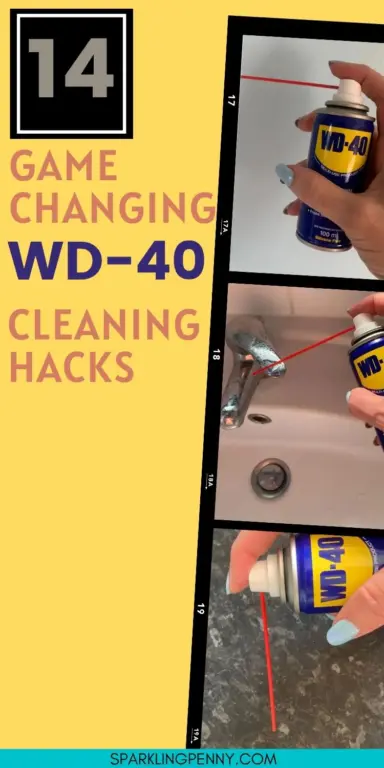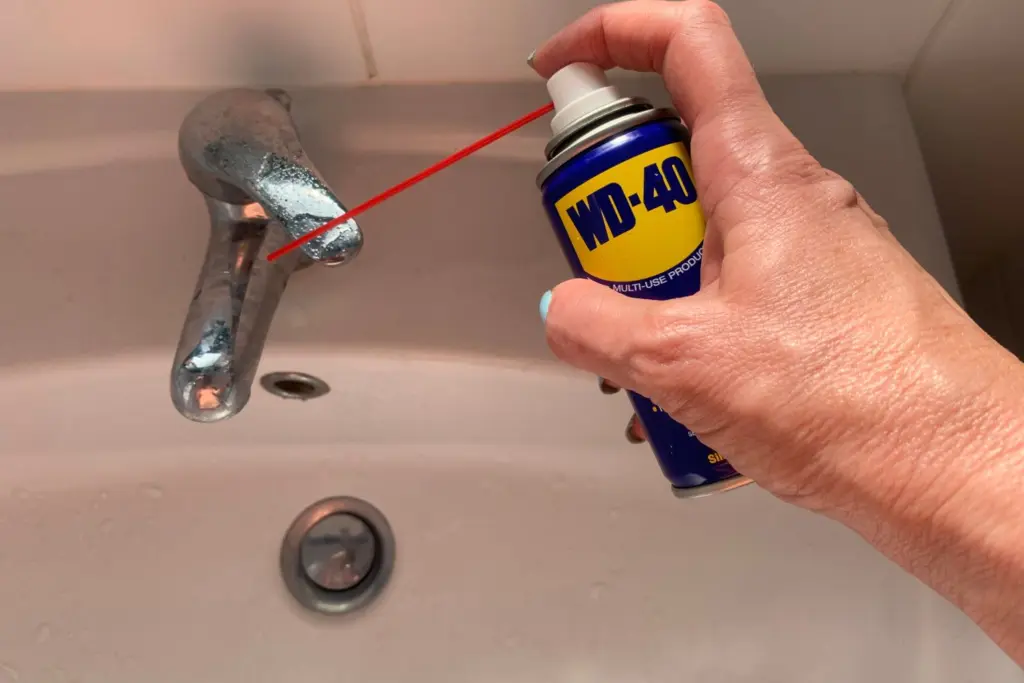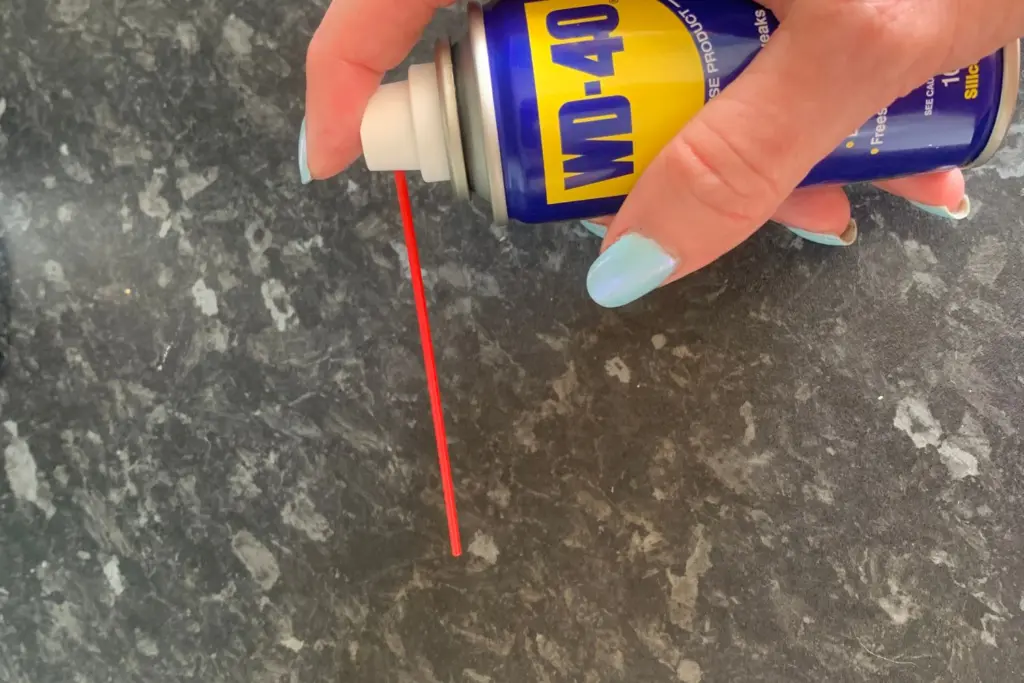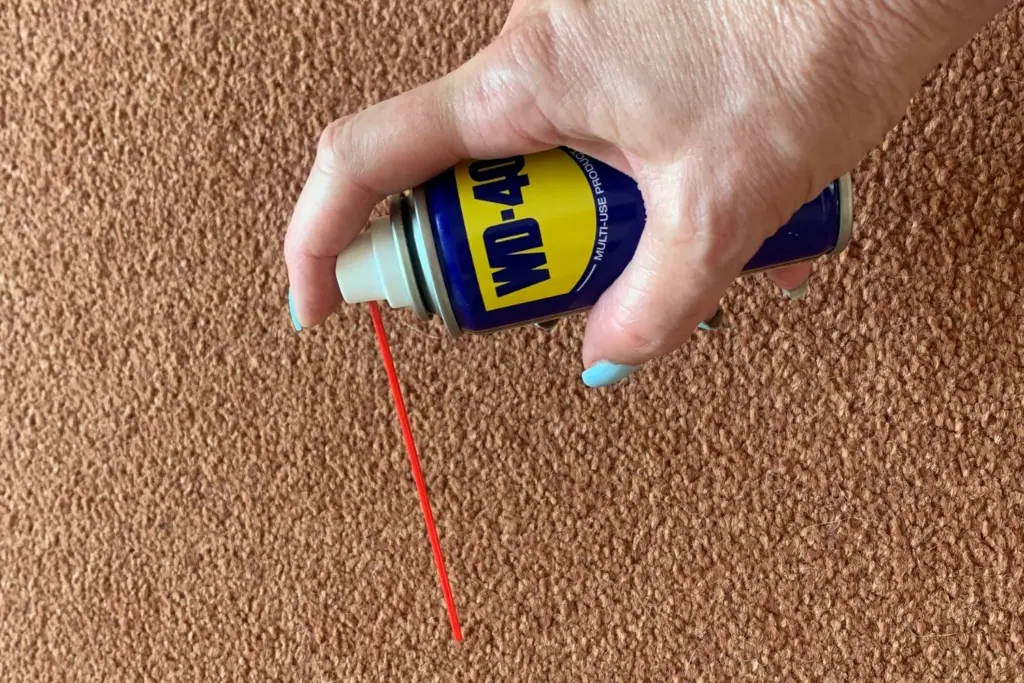Many people think WD-40 is just for squeaky hinges and rusty bolts. But this innocent can actually has some pretty wild cleaning powers!
WD-40 can remove sticky residue, clean appliances, and tackle tough stains that regular cleaners can’t handle.
These hacks save you money and time, and actually work better than often overpriced specialty cleaners.
Make sure to read this post to the very end to learn how to clean everything from kitchen appliances to some surprising household items.
No time to read this now?
Click here to save this idea for later!
↓↓↓↓↓

Heads up: I sometimes use affiliate links. When you click these links and make a purchase, I may get a small commission. It won’t cost you anything but it helps me to run this site.
1. Remove Sticker Residue Effortlessly
Stubborn sticker residue? WD-40 handles it in minutes. Spray a bit directly on the sticky area and let it hang out for 30 seconds.
The oil gets into the adhesive and breaks it down. Wipe away the gunk with a clean cloth or paper towel.
For ancient, thick residue, spray again and use a plastic scraper to gently lift it off. The residue peels away—no damage to your surface.
This method works on:
- Glass windows and mirrors
- Plastic containers
- Metal surfaces
- Painted walls
- Car bumpers
Wash the area with soap and water afterward. That gets rid of any oily leftovers and leaves your surface looking clean, not greasy.
2. Clean And Protect Stainless Steel
WD-40 leaves stainless steel appliances streak-free. Spray a light coat on your fridge, dishwasher, or sink.
Wipe with a microfiber cloth, following the grain. It zaps fingerprints, water spots, and food stains in seconds.
Your stainless steel will shine like new. The WD-40 even puts up a shield against future fingerprints and watermarks.
Follow these steps:
- Spray WD-40 on the surface
- Wait 10 seconds
- Wipe with grain direction
- Buff with dry cloth
Go one small section at a time. Too much product gets things greasy, so easy does it.
3. Revive Rusty Tools
Spray the rusty spots and let it soak in for 10 minutes.
The rust starts to loosen up. Scrub with steel wool or a wire brush and watch the rust disappear.
Heavy rust might need a second round. Most surface rust goes away after one treatment, but deep rust is a bit more stubborn.
Best tools to treat:
- Wrenches and pliers
- Garden tools
- Drill bits
- Saw blades
- Screwdrivers
After cleaning, add a thin coat of WD-40 to keep rust from coming back. Store your tools somewhere dry for best results.
4. Remove Crayon Marks On Walls
Crayon marks on painted walls? WD-40 makes them vanish. Spray a little on a clean cloth—not directly on the wall—and rub the mark in circles.
The waxy crayon moves onto your cloth. Switch to a clean cloth section as it comes off.
Most marks disappear in under 30 seconds. Wash the wall with mild soap and water to get rid of any oily residue.
Important tips:
- Test on a hidden area first
- Use just a little product
- Be gentle to protect the paint
- Wash with soap after
This trick works on flat, semi-gloss, and gloss finishes. No weird stains or paint damage left behind.
5. Shine Bathroom Fixtures

Want shiny bathroom fixtures? WD-40 works magic. Spray a little on faucets, towel bars, and shower heads.
Wipe them down with a soft cloth. Water spots and soap scum come right off.
Chrome fixtures love this method. The shine comes back without scratching.
For brass fixtures, always test a small spot first. Some brass can be picky.
Clean your fixtures this way once a week. Your bathroom will look way brighter.
Wipe off any extra WD-40 so things don’t get slippery. No one wants a surprise slide in the bathroom.
6. Clean Glass Shower Doors
Cloudy glass shower doors? WD-40 cuts through the mess. Spray it on the glass and wait two minutes.
Wipe with a clean cloth in circles. Soap scum comes right off.
Stubborn spots? Spray again, wait longer, and use a soft brush. Rinse with warm water and dry with a towel or squeegee.
Your shower doors will be sparkling. Plus, they’ll repel water better for a while.
7. Restore Kitchen Countertops

Kitchen countertops get grubby fast. WD-40 can help some of them bounce back.
Laminate countertops respond well. Sticky stuff and light scratches disappear.
Spray a bit, rub with a soft cloth, and wash off the WD-40 with dish soap and water. That last step’s important for food safety.
Don’t use WD-40 on granite or marble. It can mess up those natural stones.
Always test in a hidden spot first. Better safe than sorry!
Can’t get motivated?
#10 works every time I use it!
8. Prevent Mildew Build-Up
Mildew loves damp corners. WD-40 can help keep it away.
Spray WD-40 where mildew usually pops up—think bathroom corners and window sills. Wipe down the surface after spraying.
The product makes it hard for mildew to stick. Too much, though, and you’ll just attract dust.
Reapply every few months. And hey, make sure your rooms have good airflow too. WD-40 works best with decent ventilation.
9. Unstick Zippers And Sliding Doors
Spray a little WD-40 on stuck zippers. Work the zipper up and down slowly. Suddenly, it glides like new.
For sliding doors, spray the tracks (after cleaning out the dirt, of course). The door will slide much smoother.
Safety tip: Wipe up any extra WD-40 so nobody slips near the door.
I’ve used this on patio doors that barely moved before. The fix is instant and lasts for weeks.
10. Renew Outdoor Furniture
WD-40 zaps rust spots on metal patio furniture. Spray, wait 10 minutes, then wipe clean. The oil breaks down rust and helps stop it from coming back.
Plastic furniture looking sad? WD-40 brings back the color and shine. Just apply a thin layer and buff it in. Works wonders on those white chairs that have turned yellow.
What you’ll need:
- Clean rags
- WD-40 spray
- Mild soap for a final wipe-down
Your furniture will look refreshed—no need to buy new stuff or hire a pro.
11. Remove Carpet Stains

WD-40 handles oil-based stains regular carpet cleaners can’t touch. Spray a little on crayon marks, gum, or grease stains. Let it sit for 30 minutes.
Blot with a clean cloth to lift the stain. Follow up with dish soap and warm water to get rid of any WD-40 left behind. Always test on a hidden part of your carpet first.
Quick steps:
- Spray WD-40 on stain
- Wait 30 minutes
- Blot with clean cloth
- Clean with soap and water
This trick saved my living room carpet after the kids ground crayon into the fibers. No judgment, right?
12. Dissolve Chewing Gum
Chewing gum stuck where it shouldn’t be? WD-40’s got you. Spray a little directly on the gum and wait 30 seconds.
The oil breaks down the sticky bits. Scrape off the gum with a plastic scraper or an old credit card—go slow so you don’t mess up the surface.
Where this works:
- Carpet and fabric
- Car seats and floor mats
- Concrete and brick
- Hair and clothing
Clean the area with soap and water after. I’ve used this on my car’s floor mats and, honestly, it worked like a charm.
13. Polish Garden Tools
WD-40 keeps garden tools looking new and stops rust. Spray it on metal surfaces—shovels, rakes, pruning shears, whatever you’ve got.
Wipe with a clean cloth. Dirt comes off and a protective layer keeps moisture (and rust) away.
The oil even makes soil slide off tools easier. No more caked-on mud next time you’re digging around.
Best tools for this:
- Metal shovels and spades
- Pruning shears and loppers
- Rake heads and hoe blades
- Wheelbarrow metal parts
Clean your tools before spraying for best results. I do this at the end of each season—my tools stay rust-free all winter. Not bad for a can of WD-40, right?
14. Erase Shoe Scuff Marks
Black scuff marks on floors can be pretty stubborn, right? WD-40 actually makes them vanish fast.
Spray a little WD-40 on a cloth. Don’t go wild and spray it right on the floor unless you like living dangerously.
Rub the spot gently in circles. The scuff should lift off, and you won’t scratch up the surface.
This trick works on tile, linoleum, and sealed wood floors. Still, it’s smart to test a tiny hidden patch first—just in case your floor is extra sensitive.
Works best on:
- Vinyl and linoleum floors
- Ceramic and porcelain tiles
- Painted walls and baseboards
- Rubber shoe soles
Afterward, clean the spot with your usual floor cleaner. That way, you get rid of any slippery residue.
